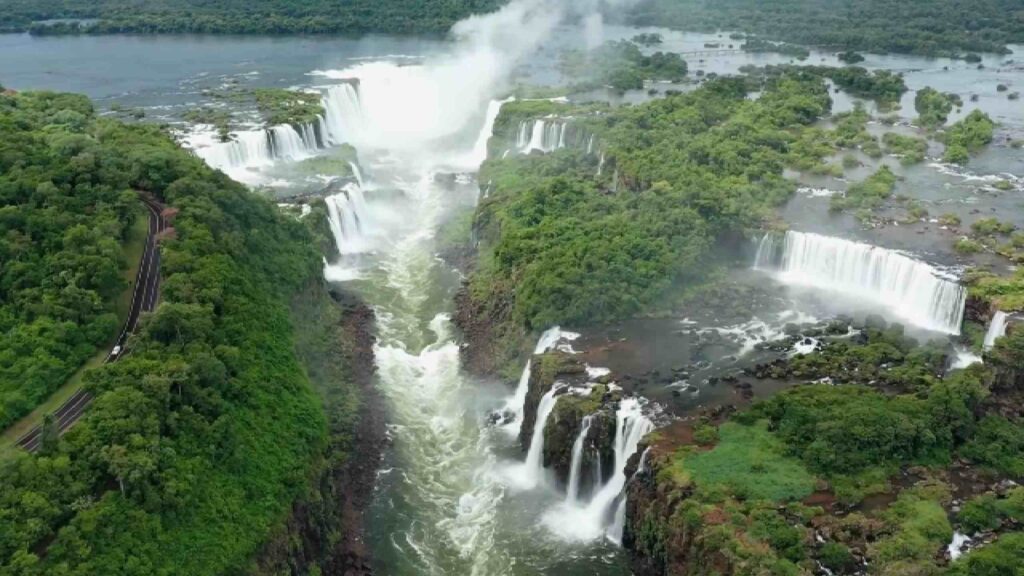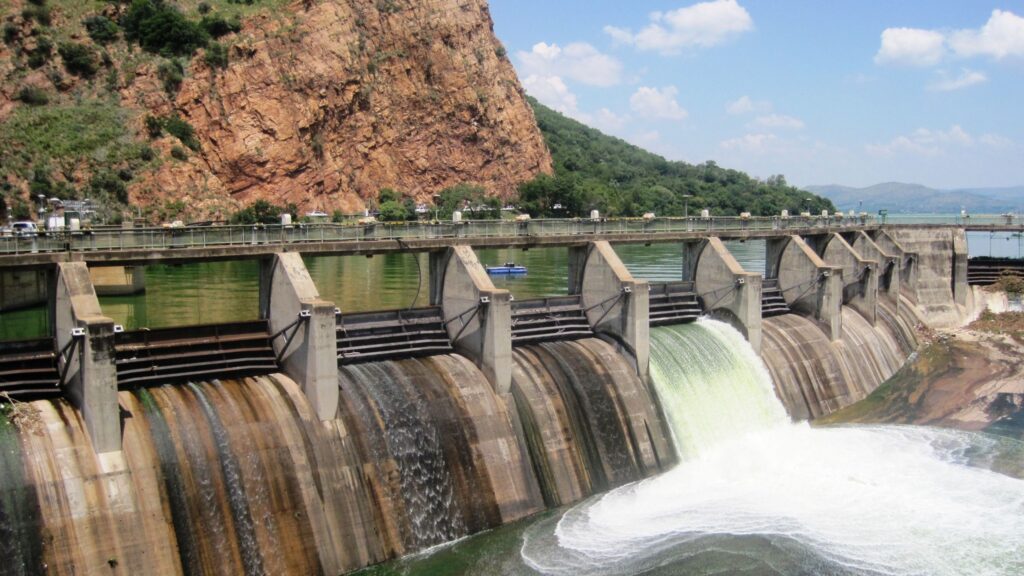Iguazu Falls is one of the most awe-inspiring natural wonders in the world, straddling the border between Argentina and Brazil. Known for its breathtaking beauty and immense scale, the falls offer an unforgettable experience for travelers. Exploring the lush rainforests of Argentina or enjoying panoramic views from Brazil’s iconic viewpoints, trips to Iguazu Falls promise a spectacular adventure. Provides all the essential information to help you plan a memorable visit, from the best times to go to insider tips on what to see and do in both countries. Get ready to immerse yourself in one of the world’s most incredible landscapes.
Iguazu Falls is one of the world’s most spectacular and impressive waterfalls, straddling the border between Argentina and Brazil in South America.
With more than 275 individual cascades, Iguazu is actually the biggest waterfall system in the world! The closest comparison is probably Niagara Falls in Canada and the United States, although Iguazu Falls is bigger than Niagara by most measurements.
This spectacular waterfall has been made into a national park in Argentina and Brazil, and both sides of the falls are well worth a visit since they offer different views! You can see the best highlights of Iguazu in a couple of days, although you could easily spend longer.
Where is Iguazu Falls?
Iguazu Falls, one of the most Amazing natural wonders in the world, straddles the border between Brazil and Argentina. This magnificent spectacle consists of over 275 individual cascades, stretching nearly two miles along the Iguazu River. As a UNESCO World Heritage site, Iguazu Falls is a must-visit for nature lovers and adventure seekers alike. This complete guide will explore the main attractions, planning tips, best experiences, differences between the two sides, and safety guidelines for your unforgettable visit to Iguazu Falls.
Iguazu Falls is located on the border of Argentina and Brazil, in the continent of South America.
There are towns and airports on both sides of the border, with plenty of tourist friendly hotels and restaurants, and you can easily go back and forth between the two countries to see both sides of the waterfall.
The town on the Argentine side of the falls is called Puerto Iguazu, while the Brazil side is called Foz do Iguacu.
How to Get There?
The main way to get to Iguazu Falls is by flying there from one of the big cities in Argentina or Brazil.
For the Argentina side, you can fly from Buenos Aires to Puerto Iguazu airport (IGR), which takes less than 2 hours and is offered by multiple airlines, with pretty reasonable prices. There are two airports in Buenos Aires (AEP or EZE) and you can use either of them to fly here.
If you’re in Brazil, you can fly from Sao Paulo or Rio De Janeiro to Foz do Iguacu airport (IGU), which takes about 2 hours, more or less. These routes are also offered by multiple airlines with daily departures.
Once you arrive in the town of Puerto Iguazu, you can get to the Argentina waterfall by bus, taxi, or tour. The bus is cheap, safe, and easy to use, with regular departures from the bus terminal in town to the waterfall, and back.
If you want something more personalized and convenient, then a taxi or private tour can be a good option. Ask the driver to wait for you while you explore the waterfall, and then take you back to town afterwards.
The Brazil side of Iguazu Falls works much the same way. Get to the Brazil waterfall by bus, taxi, or tour, and all of these options work well depending on your needs and how much time you have in your itinerary.
What are the main attractions at Iguazu Falls in Brazil and Argentina?
Iguazu National Park
Iguazu National Park is a vast expanse of lush rainforest, home to diverse flora and fauna, and offers visitors a unique opportunity to witness the stunning beauty of Iguazu Falls. The park protects not only the falls but also the surrounding ecosystems that thrive in this biodiverse environment. The park is divided into two main sections: the Brazilian national park and the Argentinian side, each providing its own unique perspective and experiences. Visitors can explore well-maintained trails, observe wildlife, and enjoy spectacular views of the falls, making this national park a true paradise for nature enthusiasts.
Key Features of the Brazilian Side of Iguazu Falls
The Brazilian side of Iguazu Falls offers some of the most iconic views of the falls, with panoramic vistas that allow visitors to appreciate the sheer scale and power of this natural wonder. One of the must-see spots on the Brazilian side is the “Devil’s Throat” or “Garganta del Diablo,” which is the largest and most impressive of the falls. The Brazilian park entrance is conveniently located, and visitors can easily access the viewing platforms that provide breathtaking views across to the Argentinian side. The well-designed walkways lead you close to the falls, allowing you to feel the mist and hear the thundering water up close, creating an unforgettable experience.
Must-See Spots on the Argentina Side of Iguazu Falls
This side offers an up-close and immersive experience, allowing visitors to witness the sheer power and majesty of the falls from various vantage points. Don’t miss the iconic Garganta del Diablo (Devil’s Throat), where the roar of cascading water will leave you in awe. Explore the extensive network of trails that wind through lush rainforest, offering glimpses of diverse wildlife and flora. The panoramic viewpoints provide spectacular photo opportunities, capturing the falls in all their glory. Adventurous visitors can also embark on boat rides that take them directly under the falls, ensuring an unforgettable experience. Nature enthusiast, a photographer, or simply seeking adventure, the Argentina side of Iguazu Falls promises unforgettable moments and memories that will last a lifetime.
How to Plan your Trip to Iguazu Falls from Brazil and Argentina?
Best Time to Visit Iguazu Falls
The best time to visit Iguazu Falls varies slightly depending on whether you are travelling to the Brazilian side or the Argentinian side. Generally, the months of March to May and September to November are ideal, as they offer mild weather and lower tourist traffic. During these months, the flow of water in the Iguazu River is also typically at its peak, enhancing the power and beauty of the falls. However, if you wish to avoid crowds, visiting during the shoulder seasons can provide a more serene experience as you explore the park.
Transportation Options for Visiting the falls
Once you arrive in Puerto Iguazu, getting to the falls is easy, as both the Brazilian and Argentinian sides are only a short drive away. Taxis and local buses are readily available, and many hotels offer shuttle services to and from the park entrances. Within Iguazu National Park, both sides have well-marked walking trails and transportation options, including panoramic train services on the Argentinian side that take you closer to the various attractions. For those looking for a more adventurous experience, helicopter tours are also available, providing stunning aerial views of the falls and surrounding landscapes.
What are the best ways to experience Iguazu Falls?
Walking Trails on the Brazilian Side of Iguazu Falls
Exploring the walking trails on the Brazilian side of Iguazu Falls is a delightful way to experience the natural beauty of the park. The well-maintained paths offer easy access to various viewpoints, allowing visitors to capture stunning photographs of the falls. The main trail leads to the viewing platform at the edge of the falls, where you can feel the refreshing mist on your face and witness the impressive flow of water cascading down. The proximity to the falls creates an exhilarating experience that is hard to forget. Additionally, the trails are surrounded by rich vegetation, making it possible to spot diverse wildlife, including colorful birds and butterflies as you walk.
Boat Tours and Other Activities in the National Park
For those looking for an adrenaline rush, boat tours are available that take you close to the base of the falls. These boat excursions provide an exhilarating experience as you navigate the powerful currents of the Iguazu River, getting soaked by the spray of the falls. The thrill of the boat ride, combined with the breathtaking surroundings, makes for an unforgettable adventure. Other activities within the park include guided tours, wildlife spotting excursions, and even zip-lining opportunities for the more adventurous traveller, ensuring that there’s something for everyone to enjoy during their visit.
Viewing Platforms for the Best Views of the Falls
Both the Brazilian and Argentinian sides of Iguazu Falls boast incredible viewing platforms that allow visitors to take in the magnificent views. The Brazilian side offers expansive panoramic vistas, perfect for capturing the entire cascade in one frame. In contrast, the Argentinian side provides more intimate spots to appreciate the falls from various angles. Each viewing platform presents a unique perspective of the falls, highlighting different features and allowing you to truly admire the beauty and power of Iguazu Falls. It is advisable to allocate enough time to explore both sides to fully appreciate the diverse views offered by this stunning natural wonder.
What are the differences between the Brazilian and Argentine sides of Iguazu Falls?
Experiences on the Brazilian Side of Iguazu Falls
The Brazilian side of Iguazu Falls is renowned for its sweeping vistas, offering visitors a chance to see the falls in their entirety. This side is particularly popular for photography, as it allows for stunning panoramic shots. The layout of the park is designed to accommodate visitors with a focus on accessibility and ease of navigation. Additionally, the Brazilian side tends to be less crowded than the Argentinian side, providing a more tranquil atmosphere for appreciating the breathtaking scenery. Visitors can also enjoy an array of amenities, including restaurants and shops, making it easy to spend a full day exploring the Brazilian national park.
Differences in Accessibility and Park Facilities
When comparing accessibility and park facilities, the Brazilian side of Iguazu Falls is often considered more user-friendly, with well-marked paths and a more compact layout. The park entrance is easily accessible, and the trails are designed for visitors of all ages. In contrast, the Argentinian side offers a more extensive network of trails, which can require more time to explore fully. While both sides provide excellent facilities, the Brazilian side’s simplicity and ease of access make it an attractive option for families and those looking for a more laid-back experience.
Comparison of Views and Landscapes from Each Side
The views from the Brazilian and Argentinian sides of Iguazu Falls differ significantly, creating unique experiences for visitors. The Brazilian side allows for a grand overview of the entire waterfall system, perfect for capturing the sheer size and grandeur of the falls. In contrast, the Argentinian side provides a more immersive experience, allowing visitors to get up close to various cascades and explore the intricate details of the falls. Each side has its own charm, and both are essential for a complete understanding of the awe-inspiring beauty of Iguazu Falls.
How can Visitors Enjoy the Iguazu Falls Experience Safely?
Safety Tips for Visiting the Falls in Brazil and Argentina
Safety should always be a priority when visiting natural attractions such as Iguazu Falls. It is essential to stay on designated paths and follow park rules to ensure the safety of both visitors and the environment. Be aware of your surroundings, especially near the edges of the falls, as the powerful currents can be deceptive. Additionally, it is advisable to wear appropriate footwear and clothing to navigate the trails comfortably. When participating in boat tours, listen carefully to safety instructions provided by the guides to ensure a safe and enjoyable experience.
What to Wear and Prepare for your Visit to Iguazu Falls
When preparing for your visit to Iguazu Falls, it’s essential to dress appropriately for the weather and activities you plan to engage in. Lightweight, breathable clothing is ideal, along with sturdy walking shoes for exploring the trails. A waterproof jacket is also advisable, as the mist from the falls can be quite refreshing but may leave you wet. Don’t forget to bring sunscreen and insect repellent, as the park’s tropical climate can be sunny and buggy. Carrying a reusable water bottle is recommended to stay hydrated while exploring the park.
Guidelines for Preserving the Natural Environment at the Falls
Preserving the natural environment at Iguazu Falls is crucial to maintaining its beauty for future generations. Visitors should respect the park’s regulations by not littering and by staying on marked paths to protect the delicate ecosystems. It’s essential to refrain from feeding wildlife and to observe animals from a distance. Educating oneself about the local flora and fauna can enhance your appreciation of the park’s biodiversity. By following these simple guidelines, visitors can contribute to the conservation of this stunning natural wonder while enjoying the breathtaking beauty of Iguazu Falls.
Iguazu Falls is a breathtaking natural wonder that promises an unforgettable adventure. Drawn by its thundering cascades, lush rainforest surroundings, or rich wildlife, visiting Iguazu offers a perfect blend of thrill and serenity. Plan your trip with care, respect the environment, and immerse yourself in one of the most spectacular waterfall systems on Earth.
FAQs
What is the best time of year to visit Iguazu Falls?
The ideal time to visit Iguazu Falls is during the shoulder seasons — March to May and August to October. These months offer pleasant weather, fewer crowds, and good water flow for stunning views and boat rides.
How do I get to Iguazu Falls?
You can reach Iguazu Falls by flying into either Foz do Iguaçu (Brazil) or Puerto Iguazú (Argentina). Both cities have airports with connections from major hubs like São Paulo and Buenos Aires. From there, local transport or tours will take you to the national parks.
Do I need a visa to visit both sides of Iguazu Falls?
Yes, depending on your nationality, you may need separate visas to enter Brazil and Argentina. Check visa requirements in advance if you plan to explore both sides of the falls.
How many days should I spend at Iguazu Falls?
Spend at least 2 to 3 days to fully explore both the Argentine and Brazilian sides. Each side offers unique perspectives and activities, from panoramic views to jungle trails and boat safaris.
Is it worth visiting both the Argentine and Brazilian sides?
Absolutely! The Argentine side allows for up-close encounters and walking trails across the waterfalls, while the Brazilian side offers breathtaking panoramic views of the entire waterfall system.
Are there guided tours available at Iguazu Falls?
Yes, guided tours are widely available and often include transport, park entry, boat rides, and bilingual guides. They’re a great way to learn about the falls, local ecology, and wildlife.
What activities can I do at Iguazu Falls?
Popular activities include:
- Walking trails and boardwalks
- Boat rides under the falls
- Birdwatching and wildlife tours
- Helicopter rides (Brazil side)
- Visit to the Itaipu Dam
What should I wear to Iguazu Falls?
Wear light, breathable clothing, comfortable walking shoes, and a waterproof jacket or poncho. Bring a hat, sunscreen, and bug repellent, as well as a waterproof bag for your camera or phone.










